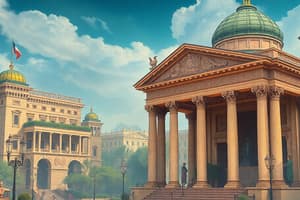Podcast
Questions and Answers
The Augustus statue communicates several messages. Which of the following interpretations best captures the intended meaning behind the statue's design?
The Augustus statue communicates several messages. Which of the following interpretations best captures the intended meaning behind the statue's design?
- Augustus possessed a youthful and powerful image, suggesting beauty, strength, and a forward-looking vision that surpassed the concerns of ordinary politicians. (correct)
- Augustus was primarily concerned with maintaining the traditions of the Roman Republic and ensuring that power remained with the Senate.
- Augustus sought to connect with people on a personal level, engaging in friendly conversations and demonstrating his approachability.
- Augustus was a humble leader who valued the opinions and perspectives of his constituents.
What is the significance of the Augustus statue being found in Meroe, Northern Sudan, with its head buried?
What is the significance of the Augustus statue being found in Meroe, Northern Sudan, with its head buried?
- It indicates Augustus's desire to expand the Roman Empire into Africa and establish trade relations with the Kingdom of Kush.
- It symbolizes the queen of Meroe's triumph over Augustus, as she buried his head to be stepped upon, signifying her dominance and revenge. (correct)
- It represents the statue being lost during transport.
- It suggests that the queen of Meroe respected Augustus and wished to honor him by burying his statue in a place of reverence.
Augustus employed various strategies to consolidate his power. Which of the following methods did he use to legitimize his rule in the eyes of the Roman people?
Augustus employed various strategies to consolidate his power. Which of the following methods did he use to legitimize his rule in the eyes of the Roman people?
- He transferred the government to the people, creating the illusion of a republic while establishing a monarchy. (correct)
- He openly declared himself dictator for life, centralizing all political authority in his hands.
- He focused on military conquests to expand the empire, securing resources and wealth for the Roman people.
- He eliminated the Senate and established a new council made up of his loyal followers.
How did Augustus use festivals involving exotic animals to reinforce his authority and influence?
How did Augustus use festivals involving exotic animals to reinforce his authority and influence?
What was the prevailing attitude of the Roman government towards diverse cultures and religions during the time of Jesus?
What was the prevailing attitude of the Roman government towards diverse cultures and religions during the time of Jesus?
Why were Pliny's neighbors angry?
Why were Pliny's neighbors angry?
According to Pliny's findings, what was a key practice of Christians that he observed?
According to Pliny's findings, what was a key practice of Christians that he observed?
What actions did Pliny take in response to his findings about the Christians?
What actions did Pliny take in response to his findings about the Christians?
According to Emperor Trajan's response to Pliny, what was the acceptable course of action regarding Christians?
According to Emperor Trajan's response to Pliny, what was the acceptable course of action regarding Christians?
Why did the Romans perceive Christianity as a dangerous superstition, setting it apart from Judaism?
Why did the Romans perceive Christianity as a dangerous superstition, setting it apart from Judaism?
What was the most revolutionary aspect of Jesus' teachings that contributed to the rapid spread of Christianity?
What was the most revolutionary aspect of Jesus' teachings that contributed to the rapid spread of Christianity?
Why is Paul considered a pivotal figure in the early development of Christianity?
Why is Paul considered a pivotal figure in the early development of Christianity?
The traditional claim about the fall of Rome centers on barbarian invasions. What is the core argument of this claim?
The traditional claim about the fall of Rome centers on barbarian invasions. What is the core argument of this claim?
What is the central idea behind the claim that Rome was 'doomed to fall' due to overexpansion?
What is the central idea behind the claim that Rome was 'doomed to fall' due to overexpansion?
John Green argues for continuity between the Western and Eastern Roman Empires. What is the essence of his argument?
John Green argues for continuity between the Western and Eastern Roman Empires. What is the essence of his argument?
Which of the following represents a key difference between the Western and Eastern Roman Empires that argues against a continuity between them?
Which of the following represents a key difference between the Western and Eastern Roman Empires that argues against a continuity between them?
Based on the information presented, which piece of evidence most strongly supports the argument that the Western Roman Empire definitively fell in 476 CE?
Based on the information presented, which piece of evidence most strongly supports the argument that the Western Roman Empire definitively fell in 476 CE?
How did Pliny's treatment of individuals claiming to be Christian differ from established Roman policy toward Judaism, and what implication did this have?
How did Pliny's treatment of individuals claiming to be Christian differ from established Roman policy toward Judaism, and what implication did this have?
Flashcards
Augustus' Statue Messaging
Augustus' Statue Messaging
Communicated power, youth, and divine status through calculated hair and posture.
Augustus' Legitimacy Trick
Augustus' Legitimacy Trick
Augustus transferred government power in name only, establishing a monarchy while appearing to empower the people.
Exploitation of Misfortune
Exploitation of Misfortune
Public misfortunes were used to manipulate the public into believing Augustus needed dictatorial power.
Roman Religious Climate
Roman Religious Climate
Signup and view all the flashcards
Jewish Expectation of a Messiah
Jewish Expectation of a Messiah
Signup and view all the flashcards
Who was Pliny?
Who was Pliny?
Signup and view all the flashcards
Why were the neighbors angry with the Christians?
Why were the neighbors angry with the Christians?
Signup and view all the flashcards
Pliny's Findings on Christians
Pliny's Findings on Christians
Signup and view all the flashcards
Pliny's Treatment of Christians
Pliny's Treatment of Christians
Signup and view all the flashcards
Trajan's Response to Pliny
Trajan's Response to Pliny
Signup and view all the flashcards
Significance of Pliny's Actions
Significance of Pliny's Actions
Signup and view all the flashcards
Roman Views on Christianity
Roman Views on Christianity
Signup and view all the flashcards
Core Teachings of Jesus
Core Teachings of Jesus
Signup and view all the flashcards
Role of Paul
Role of Paul
Signup and view all the flashcards
"Barbarians at the Gate" claim
"Barbarians at the Gate" claim
Signup and view all the flashcards
Hipper Claim
Hipper Claim
Signup and view all the flashcards
John Green’s Claim
John Green’s Claim
Signup and view all the flashcards
Collapse of the Western Roman Empire
Collapse of the Western Roman Empire
Signup and view all the flashcards
Study Notes
- Augustus used his statue to communicate messages of power, youth, and calculated beauty.
- The statue shows him always looking past you, suggesting he is focused on more important matters.
- His curly hair is styled to convey both beauty and power.
- The tilt of his head suggests conversation, but his superior stature is emphasized.
- Augustus aimed to appear greater than everyone, including politicians.
- The statue spans Augustus's age from 19 to 76 years.
Discovery of the Statue
- The statue was found in Meroe, Northern Sudan.
- The Queen of Meroe buried the head, ensuring it would be stepped on, symbolically degrading Augustus.
Augustus's Acquisition of Legitimacy
- Augustus transferred the government to the people, creating a deceptive appearance of a better system.
- He was essentially establishing a monarchy under the guise of a republic.
- Festivals featuring exotic animals demonstrated his power and control.
- Misfortunes were exploited to convince people of Augustus's need for greater power, almost leading to his appointment as dictator.
Religious Changes Under Augustus
- People were manipulated into perceiving Augustus as divine, the son of a god.
Santa Maria Antiqua Sarcophagus
- It reveals Christians were concerned with the afterlife and were wealthy.
- The story of Jonah and the Whale symbolizes faith.
Political and Religious Climate During Jesus's Time
- The Roman government, while open to diverse cultures, demanded that Roman citizens honor the Emperor above all.
- This requirement clashed with Jewish beliefs, as they refused to place anyone above their God.
- Hellenism, which promoted Greek values, was also favored by the Roman government.
- These conflicts fueled Jewish desires for freedom from Roman control and the establishment of a Jewish state, fostering belief in a Messiah.
- Jesus's teachings of compassion and forgiveness offered hope to the Jews, leading some to believe he was the Messiah.
- However, Jesus's non-violent approach and the fear that he might incite rebellion led the Romans to suppress his teachings.
Pliny and the Christians
- Pliny was a governor responsible for maintaining order.
- Neighbors were upset because temples were empty and demand for items to honor Gods had decreased.
- Pliny found that Christians met before daybreak to sing hymns and worship Christ as a god, and that they pledged to be morally good.
- Pliny interrogated suspected Christians, executing those who persisted in their faith.
- Emperor Trajan approved of Pliny's methods but advised against actively seeking out Christians and cautioned against taking accusations too seriously.
Significance of Pliny's Actions
- Christianity was initially viewed as a sect of Judaism, thus protected under Roman law, but Pliny's actions treated Christians as a separate group.
- Christians were treated differently due to Roman views on religion; Christianity was seen as a new superstition rather than an ancient tradition.
- Christians were blamed for disasters, leading to a worsening reputation and, eventually, the criminalization of Christianity.
Jesus's Teachings
- Jesus taught love, compassion, and forgiveness, even towards enemies.
- He advocated for non-violence as the path to peace.
- The belief that Jesus overcame death amplified the power of his teachings.
Paul's Role in Early Christianity
- Paul, a Jew from Asia Minor, converted to Christianity and became a devoted follower.
- He emphasized that Christianity was for everyone.
- Paul was instrumental in spreading Christianity and expanding its reach.
Traditional View of Rome's Fall
- Barbarian invasions caused the fall of Rome.
- Barbarians conquered Rome, ending the Roman Empire in Rome.
Alternative View of Rome's Fall
- Rome's overexpansion from Italy led to its downfall.
- Governing distant lands from the capital became increasingly difficult.
John Green's Perspective on Rome's Fall
- There was no singular fall; instead, there was a continuity between the Western and Eastern empires.
- The empire split into two similarly governed entities.
Similarities Between Western and Eastern Empires
- Both empires were ruled by a single leader with military power.
- Both experienced constant warfare.
- Both were wealthy due to high taxes, trade, and agriculture.
- Both were urbanized and compact.
- Both were initially governed by Roman law.
Differences Between Western and Eastern Empires
- The Eastern Empire, or Byzantine Empire, was mostly ruled by different men, and few rulers were from Rome.
- The number of political leaders varied.
- Byzantines did not speak Latin.
- The two empires followed different Christian religions: Orthodox vs. Catholic.
Conclusion on Rome's Fall
- The Roman Empire collapsed in 476 CE with the overthrow of Romulus Augustus.
- The Byzantine Empire's differences in religion, political leadership, and non-Roman rulers indicate it was not a continuation of the original Roman Empire.
- The fact that many Byzantine rulers were not Roman supports the view that it was not a continuation of the Roman Empire.
Studying That Suits You
Use AI to generate personalized quizzes and flashcards to suit your learning preferences.
Description
Augustus used statues to project power and beauty, always looking past others to appear superior. Discovered in Meroe, its burial symbolized degradation. He acquired legitimacy by feigning a republic while establishing a monarchy, using festivals and misfortunes to control public perception.





